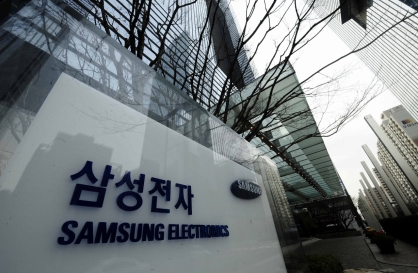Trace amounts of leukemia-linked carcinogens were found in semiconductor-producing factories of Samsung Electronics Co. and other chipmakers, a governmental authority said Monday.
“We found that cancer-causing substances are present inside the chip factories,” said Park Jung-sun, head of the state-run Korea Occupational Safety and Health Research Institute, announcing the results of its three-year study of potential cancer risks at chip-manufacturing lines.
The study, conducted between 2009 and 2011 on chip lines of Samsung, Hynix Semiconductor and Fairchild Semiconductor, confirmed the presence of benzene, formaldehyde and radiation at levels way below what is considered harmful. The three have been linked to leukemia.
It is the first time that the presence of carcinogens, long claimed by civic groups and some employees, was confirmed by an authoritative study. The same institute didn’t find any traces of the agents in two previous studies in 2007 and 2008.
There have been public health concerns over workplace safety at Samsung, the world’s No. 1 maker of computer memory chips, after some of its employees died of leukemia and other cancers while or after working at its chip manufacturing lines.
The company, however, has insisted that their deaths were not work-related. A local court last year ruled that some of the cancers the workers contracted could be classified as “industrial accidents.”
“The study says materials are present in levels that are not harmful to humans. But we will strengthen monitoring of workplace safety as it is a matter related to health and safety of our workers,” Samsung said.
According to the study released Monday, benzene was found in 0.00038 ppm and 0.00990 ppm in two different chip-making lines -- both below the permitted 1 ppm. Exposure to such low levels poses no health risks over the lifetime of a worker who works eight hours per day at the plant, the study said.
However, arsenic, a known carcinogen linked to lung cancer, was present above the permitted level, it said.
By Lee Sun-young (milaya@heraldcorp.com)
반도체공장 발암물질 발생 사실로 드러나
삼성전자를 비롯한 반도체 공장의 백혈병 위험도를 정밀 연구한 결과 백혈병 유발인자인 벤젠과 포름알데히드 등이 실제 제조 공정에서 발생하는 것으로 나타났다.
폐암 유발인자로 알려진 비소는 노출기준을 초과해 대책이 필요한 것으로 지적 됐다.
산업안전보건연구원은 이러한 내용의 ‘반도체 제조 사업장 정밀 작업환경 연구결과를 6일 발표했다.
연구원은 2009년부터 3년간 삼성전자와 하이닉스, 페어차일드코리아 등 백혈병이 발생한 사업장 및 유사공정 사업장의 웨이퍼 가공라인(5개소) 및 반도체 조립라인(4개소)을 대상으로 발암물질을 측정했다.
조사결과 백혈병 유발인자인 벤젠은 웨이퍼 가공라인과 반도체 조립라인 일부 공정에서 부산물로 발생했다.
다만 검출농도는 가공라인에서 최대 0.00038ppm, 조립라인에서 최대 0.00990ppm으로, 둘 다 노출기준(1ppm) 보다는 훨씬 낮았다.
노출기준 보다 낮다는 것은 하루 8시간 근무할 경우를 가정해 해당 작업장에서 평생 일하더라도 건강에 문제가 없는 수준이라고 연구원 측은 설명했다.
또 다른 백혈병 유발인자인 포름알데히드 역시 부산물로 발생하는것으로 나타났다.
포름알데히드의 노출기준은 0.5ppm으로, 가공라인에서는 자연환경수준인 최대 0 .004ppm, 조립라인에서는 자연환경보다 약간 높은 수준인 최대 0.015ppm이 검출됐다.
전리방사선은 웨이퍼 가공라인과 반도체 조립라인에서 최대 0.015밀리시버트/년 (mSv/yr)이 측정됐다.
이는 방사선작업 종사자를 기준으로 한 개인 노출선량한도인 50밀리시버트/년보 다는 낮은 수준이었다.
백혈병 유발인자와 달리 폐암 유발인자로 알려진 비소는 웨이퍼 가공라인의 이온주입공정에서 노출기준(0.01mg/㎥)을 초과(0.001∼0.061mg/㎥)한 양이 확인됐다.
특히 이온주입공정 유지보수작업을 하는 협력업체 근로자에게 노출위험이 커 대책이 필요한 것으로 나타났다.
박정선 산업안전보건연구원장은 “이번 연구 결과는 발암물질 발생원이 공장 내에 있다는 점이 중요하다”면서 “굉장히 미미한 농도지만 기술적으로 완전히 가능한 수준으로 낮출 필요가 있다”고 지적했다.
고용노동부는 연구대상에 포함된 3개 업체에 대해 국소환기장치 보완 등 시설개 설과 작업환경 측정, 특수건강진단 추가 실시, 협력업체 근로자 건강보호 대책 등을 마련하도록 시정 조치했다.
특히 부산물로 발암성물질이 발생하는 유기화합물을 안전한 물질로 대체하도록 지시했다.
아울러 나머지 반도체 업체들도 점검을 해 필요한 조처를 할 예정이다.
반도체 공장 백혈병 환자 문제는 지난 2007년 삼성전자 직원이 근로복지공단에 산업재해를 신청하면서 알려졌다.
이후 지난 2010년 서울행정법원이 삼성 반도체 백혈병 환자에 대해 처음으로 산 재를 인정해 현재 항소심이 진행 중이다.
삼성전자는 지난해 미국 안전보건 컨설팅 회사인 인바이론(Environ)사에 의뢰해 반도체 생산라인 근무환경에 대한 연구조사를 한 결과 사업장 근무환경이 암 발병과 는 무관하다는 내용을 발표한 바 있다. (연합뉴스)



![[KH Explains] No more 'Michael' at Kakao Games](http://res.heraldm.com/phpwas/restmb_idxmake.php?idx=644&simg=/content/image/2024/04/28/20240428050183_0.jpg&u=20240428180321)




![[Grace Kao] Hybe vs. Ador: Inspiration, imitation and plagiarism](http://res.heraldm.com/phpwas/restmb_idxmake.php?idx=644&simg=/content/image/2024/04/28/20240428050220_0.jpg&u=)


![[Herald Interview] Mom’s Touch seeks to replicate success in Japan](http://res.heraldm.com/phpwas/restmb_idxmake.php?idx=644&simg=/content/image/2024/04/29/20240429050568_0.jpg&u=)







